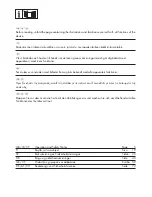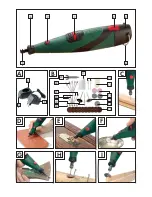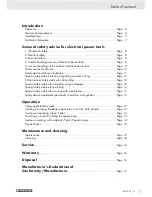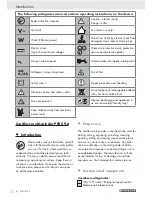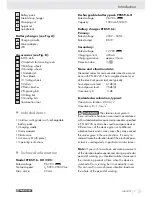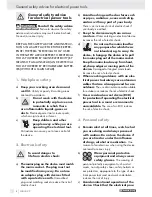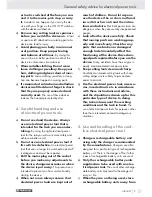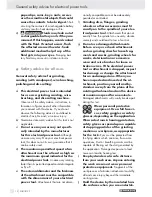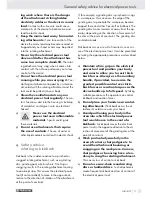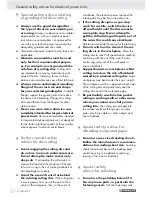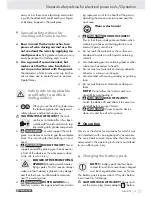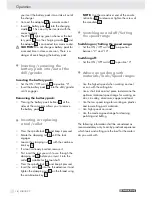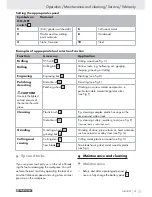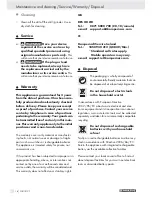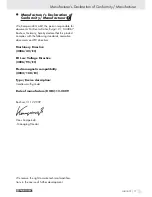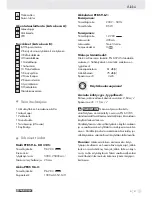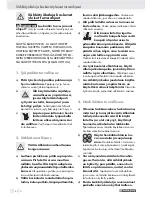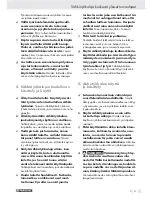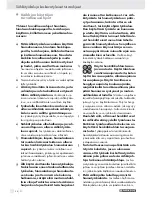
9
GB/IE/CY
er tool is switched off before you con-
nect it to the mains, pick it up or carry
it.
Accidents can happen if you carry the de-
vice with your finger on the ON / OFF switch or
with the device switched on.
d)
Remove any setting tools or spanners
before you switch the device on.
A tool
or spanner left attached to a rotating part of a
device can lead to injury.
e)
Avoid placing your body in an unnat-
ural position. Keep proper footing
and balance at all times.
By doing this
you will be in a better position to control the
device in unforeseen circumstances.
f)
Wear suitable clothing. Do not wear
loose clothing or jewellery. Keep your
hair, clothing and gloves clear of mov-
ing parts.
Loose clothing, jewellery or long
hair can become trapped in moving parts.
g)
If vacuum dust extraction and collection
devices are fitted do not forget to check
that they are properly connected and
correctly used.
The use of these devices
reduces the hazard presented by dust.
4.
Careful handling and use
of electrical power tools
a)
Do not overload the device. Always
use an electrical power tool that is
intended for the task you are under-
taking.
By using the right electrical power
tool for the job you will work more safely and
achieve a better result.
b)
Do not use an electrical power tool if
its switch is defective.
An electrical power
tool that can no longer be switched on and off
is dangerous and must be repaired.
c)
Pull the mains plug out of the socket
before you make any adjustments to
the device, change accessories or when
the device is put away.
This precaution is
intended to prevent you from unintentionally
starting the device.
d)
When not in use always ensure that
electrical power tools are kept out of
reach of children. Do not let anyone
use the device if he or she is not famil-
iar with it or has not read the instruc-
tions and advice.
Electrical power tools are
dangerous when they are used by inexperienced
people.
e)
Look after the device carefully. Check
that moving parts are working prop-
erly and move freely. Check for any
parts that are broken or damaged
enough to detrimentally affect the
functioning of the device. Have dam-
aged parts repaired before you use the
device.
Many accidents have their origins in
poorly maintained electrical power tools.
f)
Keep cutting tools clean and sharp.
Carefully maintained cutting tools with sharp
cutting edges are less likely to jam and are
easier to control.
g)
Use the electrical power tool, accesso-
ries, inserted tools etc. in accordance
with these instructions and advice,
and the stipulations drawn up for this
particular type of device. In doing
this, take into account the working
conditions and the task in hand.
The
use of electrical power tools for purposes other
than those intended can lead to dangerous
situations.
5. Use and handling of the cord-
less electrical power tool
a)
Charge a rechargeable battery unit
using only the charger recommended
by the manufacturer.
Chargers are often
designed for a particular type of rechargeable
battery unit. There is the danger of fire if other
types of rechargeable battery units are used.
b)
Only the rechargeable battery units
supplied are to be used with an elec-
trical power tool.
The use of other recharge-
able battery units may lead to the danger of
injury or fire.
c)
When they are not being used, store
rechargeable battery units away from
General safety advice for electrical power tools
Summary of Contents for PFBS 9.6 V - 6
Page 3: ...A 10 8 9 D E F G H I C B 17 16 15 13 14 19 18 22 20 21 12 11 23 5 4 1 7 2 3 6...
Page 17: ...18...
Page 31: ...32...
Page 57: ...58...
Page 59: ...60 GR CY E PFBS 9 6 E V Volt W Watt n0 mA A Ah II...
Page 61: ...62 GR CY E A 1 2...
Page 62: ...63 GR CY 3 4...
Page 63: ...64 GR CY 5...
Page 64: ...65 GR CY...
Page 65: ...66 GR CY o...
Page 66: ...67 GR CY...
Page 67: ...68 GR CY...
Page 68: ...69 GR CY 3 5 9 9 3 8 LED 10 3 8 9 1 0 3 2 3 7 5 5 23 5 18 7 18 5 23 23 12 1 2 10 1 0...
Page 69: ...70 GR CY 1 0 6 2 8 4 10 HSS 11 C 21 20 D 15 13 19 15 E...
Page 70: ...71 GR CY 3 3 14 22 G 17 16...


